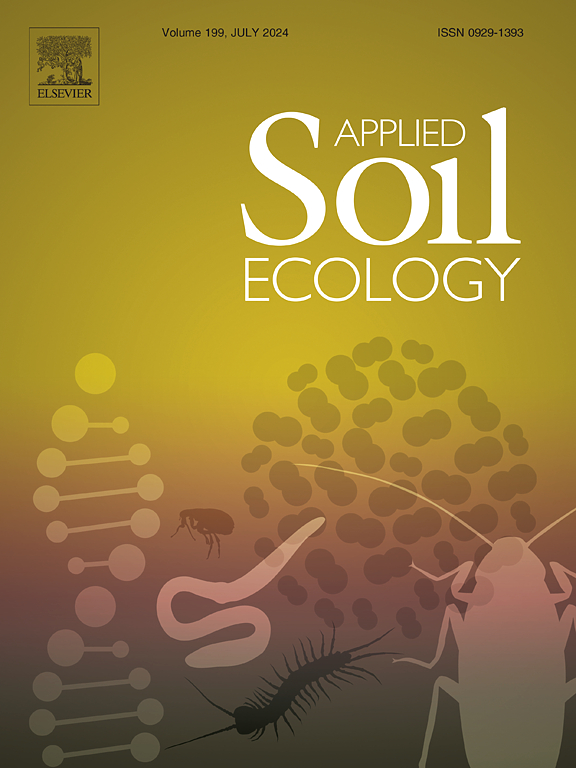Relationships between earthworm community, bioturbation and soil detachment: A one-year outdoor experiment
IF 4.8
2区 农林科学
Q1 SOIL SCIENCE
引用次数: 0
Abstract
We conducted a one-year outdoor experiment to evaluate how the functional diversity of earthworms influences soil erosion. Three species with contrasting bioturbating behaviors were selected: the polyhumic endogeic Pontoscolex corethrurus (feeding and casting on the soil surface and constructing shallow burrows), the endogeic Amynthas alluxus (geophagous and permanently living in the subsoil), and the anecic Amynthas zenkevichi (feeding and casting on the soil surface and constructing deep burrows). A total of 27 mesocosms (1 m3 each) planted with grass were inoculated with none to all three species at two biomass levels (30 and 60 g m−2). Soil detachment, water runoff, drainage, soil water potential, and grass biomass were monitored throughout the whole experiment, while burrow volume, water infiltration rate, surface casts, and earthworm communities were measured at the end. A. zenkevichi was the only surviving species and colonized all the mesocosms. Consequently, the impact of each species and their interactions on soil detachment could not be assessed. Nevertheless, mesocosms initially inoculated with earthworms showed, on average, a 7.7-fold decrease in soil detachment compared to the control mesocosm, where no earthworms were introduced at the beginning but was later colonized by dispersed earthworms. Structural equation modeling explained 77 % of the variance in soil detachment. It revealed that both surface casts and burrows (measured by X-ray tomography) indirectly reduced soil detachment by increasing water infiltration and reducing water runoff. However, surface casts also promoted water runoff, partially counteracting these benefits. This study highlights the challenges of managing earthworm communities in long-term mesocosm experiments under natural conditions. Despite these limitations, our findings emphasize the crucial role of anecic earthworms in reducing soil detachment.
我们进行了为期一年的户外实验,以评估蚯蚓的功能多样性如何影响土壤侵蚀。我们选择了生物扰动行为截然不同的三种蚯蚓:多栖内栖蚯蚓 Pontoscolex corethrurus(在土壤表面取食和投食并构建浅洞穴)、内栖蚯蚓 Amynthas alluxus(食土并长期生活在底土中)和无栖蚯蚓 Amynthas zenkevichi(在土壤表面取食和投食并构建深洞穴)。在总共 27 个种植了草的中置容器(每个 1 立方米)中,接种了两种生物量水平(30 和 60 克 m-2)的所有三个物种。在整个实验过程中监测土壤剥离、水径流、排水、土壤水势和草的生物量,并在实验结束时测量洞穴体积、水渗透率、地表菌落和蚯蚓群落。A. zenkevichi 是唯一存活的物种,并在所有中置池中定殖。因此,无法评估每个物种及其相互作用对土壤剥离的影响。不过,与对照介观模式相比,最初接种了蚯蚓的介观模式的土壤剥离率平均下降了 7.7 倍,对照介观模式开始时没有引入蚯蚓,但后来被分散的蚯蚓定殖。结构方程模型解释了土壤剥离变异的 77%。结果表明,地表蚯蚓粪和洞穴(通过 X 射线断层扫描测量)都通过增加水分渗透和减少径流间接减少了土壤剥离。然而,地表坑穴也促进了水的径流,部分抵消了这些益处。这项研究凸显了在自然条件下进行长期中观实验管理蚯蚓群落所面临的挑战。尽管存在这些局限性,但我们的研究结果强调了无尾蚯蚓在减少土壤剥离方面的关键作用。
本文章由计算机程序翻译,如有差异,请以英文原文为准。
求助全文
约1分钟内获得全文
求助全文
来源期刊

Applied Soil Ecology
农林科学-土壤科学
CiteScore
9.70
自引率
4.20%
发文量
363
审稿时长
5.3 months
期刊介绍:
Applied Soil Ecology addresses the role of soil organisms and their interactions in relation to: sustainability and productivity, nutrient cycling and other soil processes, the maintenance of soil functions, the impact of human activities on soil ecosystems and bio(techno)logical control of soil-inhabiting pests, diseases and weeds.
 求助内容:
求助内容: 应助结果提醒方式:
应助结果提醒方式:


